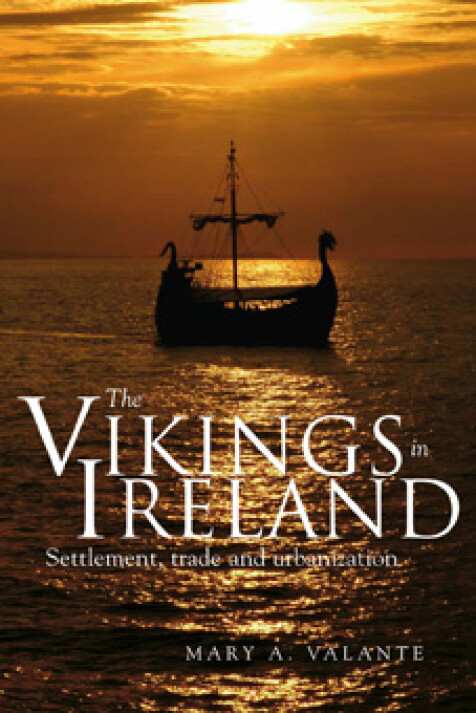The Vikings in Ireland
Settlement, trade and urbanization
Mary Valante
'The amount of research which she has carried out and the number of sources that she recommends can be determined by the twenty-two pages of bibliography at the end of the book and the average page makes reference to twenty sources, Irish, American and Scandinavian. Every page of the book lists papers or books written by from five to fourteen scholars. We can therefore be assured that no stone has been left unturned', J. Ardle McArdle, Books Ireland (April 2009).
‘Valante takes a multidisciplinary approach in her study of the complex relationship between the port town-dwelling Scandinavians and Ireland’s rural residents during the era of Viking colonization and urbanization. The study incorporates archaeological and historical evidence, geographical and anthropological research methods, and written information recorded by the Irish, Scandinavians, Anglo-Saxons, Welsh, and Anglo-Normans. The result is an engaging economic history of Ireland between the seventh century and the mid-12th century’, Book News (May 2009).
'… a fresh contribution to the field of Viking studies in Ireland is to be welcomed … Valante has a good writing style that makes the material accessible. Overall, the book is well researched and presents a wide-ranging and informative survey … This book will surely underpin further studies of Ireland’s economic history in the early Middle Ages', Clare Downham, Irish HIstorical Studies (May 2009).
“Through a thoughtful and comprehensive analysis of archaeological evidence coupled with primary written accounts and historical data, Valante provides an important portrait not only of the Vikings in Ireland, but of the medieval world with its intricate connections and deeply rooted associations. The end product is a finely wrought historical and archaeological platform from which other scholars can build and develop other areas of research and analysis, including literary and cultural studies. The book is painstakingly researched and presents potentially convoluted or contradictory evidence in a clear, concise manner supported by detailed original databases and maps … the overall work is ultimately enhanced by the attention to detail and the careful drawing together of various threads of analysis and interpretation. It is a valuable addition to scholarship not only on early medieval Ireland, but on the entire medieval world connected by the activities of Viking raiders, traders, warriors and settlers … It lays the foundation for further study in a multitude of disciplines and opens the door to a better understanding of the evolution of Ireland’s urban society', Larissa Tracey, Óenach.
‘Valante has developed a fine familiarity with the voluminous Gaelic annals, tales, saints’ lives, and legal codes and with the exploding archaeological record. She uses this to offer a more detailed analysis of the growth and influence of towns than hitherto available', E.J. Kealey, Choice (January 2010).
'The activities of Vikings in Ireland and associated maritime regions have literally been in the news recently … Mary Valante’s The Vikings in Ireland adds to the mix with a distinctive approach which focuses on the economy, particularly the phenomenon of urbanisation. Vikings operating in Ireland have always been given credit for this development, even before their rehabilitation in the historiography of the second half of the twentieth century, but Valante pushes the investigation further. She uses archaeological data (especially from urban excavations and coin hoards), but also extracts economic information from a wide range of written sources, shifting attention from the more familiar issues of social and political impact. In doing so, she sidesteps the complicated political narrative that has largely determined our understanding of the period … Valante’s bibliography, useful for students and scholars alike, is up to date until 2005. She has made the effort to include a commendable number of maps, which aim to show how the Irish experience of vikings varied across time and space … Valante has offered a useful survey of a difficult period from a fresh angle, and her book makes a contribution to the continual reshaping of the region’s history in the Viking Age', L. Abrams, English Historical Review (April 2010).
‘This book presents “a detailed study of urbanization and economy in Viking Age Ireland”. Valante collates evidence from many written sources, especially Irish annals, with archaeological findings. The work thus assembles and summarizes a large body of archaeological data in a form accessible to historians … Valante’s book reflects a great deal of work, careful comparison of archaeological and textual data, thorough bibliography, and an ambitious attempt to trace the history of Viking Ireland in just 164 pages', Kendra Willson, Speculum (2010).
‘Valante provides a coherent account of the physical, economic and political development of Ireland’s Viking towns … [she] is well versed in the comparative history of urban origins and her use of economic models and non-Irish comparanda is one of the strengths of this book … original and valuable', Elizabeth Boyle, Medieval Archaeology (Spring 2011).
'The Vikings in Ireland is a new study that balances archaeological and historical evidence, uses geographical and anthropological methods, and assesses primary written source from the Irish, Scandinavians, Welsh, Anglo-Saxons (English) and the Anglo-Normans … Valente examines the enormous economic impact that the Scandinavian settlements had on Ireland’, Michael Merrigan, Ireland’s Genealogical Gazette.

